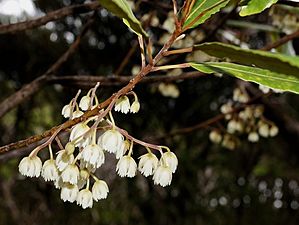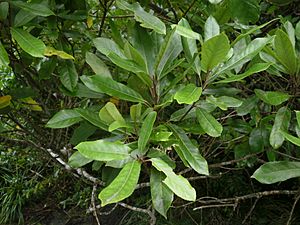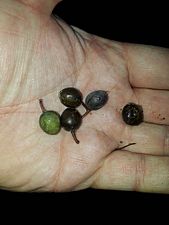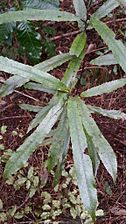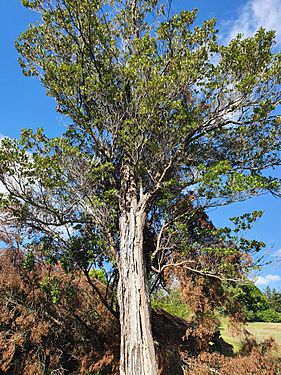Hinau facts for kids
Quick facts for kids Hinau |
|
|---|---|
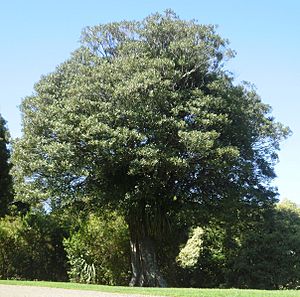 |
|
| Scientific classification | |
| Genus: |
Elaeocarpus
|
| Species: |
dentatus
|
| Varieties | |
|
|
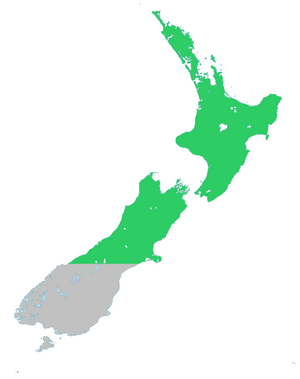 |
|
| Natural range of Hīnau | |
The Hīnau (scientific name: Elaeocarpus dentatus) is a special tree that grows in the New Zealand forests. It's also known by other Māori names like hangehange, pōkākā, and whīnau.
This tree is part of the Elaeocarpaceae family. You can find it on both the North Island and South Island of New Zealand. However, it doesn't grow on Stewart Island. Hīnau trees have dark green leaves with small teeth along their edges. If you look closely, you might see tiny bumps called domatia on the underside of the leaves. In spring, the tree produces many small white flowers. By late summer, these flowers turn into soft, fleshy fruits.
Scientists first officially recorded the Hīnau tree on November 5, 1769. This was done by botanists Joseph Banks and Daniel Solander.
Contents
What the Hīnau Tree Looks Like
The Hīnau tree can grow quite tall, reaching about 18 meters (59 feet). Its trunk can be around 1 meter (3.2 feet) wide. The bark is grey and gets rougher as the tree gets older.
Leaves and Flowers
Its leaves are tough and leathery. They are usually 10–12 cm long and 2–3 cm wide. The top side of the leaf is dark green, while the underside is an off-white color.
Hīnau flowers bloom from October to February. They look a lot like lily of the valley flowers. These white flowers hang down in clusters called racemes, which are 10–18 cm long. Each cluster has 8 to 10 flowers. Each flower is about 12 mm wide and hangs from a short, silky stem called a pedicel. The flowers have 3 to 5 petals with lobed tips. They also have long anthers that stick out. The small leaves at the base of the flower, called sepals, are covered in tiny hairs.
Fruit and Seeds
The tree starts to fruit in December, and the fruit ripens by May. The fruit are purple-black and egg-shaped. They are called drupes and are 12–18 mm long and 9 mm wide. Birds love to eat them!
The Hīnau tree has flowers with both male and female parts. This means it can produce seeds on its own. It has 15 pairs of chromosomes. The Hīnau tree is very similar to another tree called Elaeocarpus hookerianus. However, you can tell them apart because Hīnau has larger leaves, flowers, and fruit. Also, young E. hookerianus trees have a unique tangled, branchy shape that Hīnau trees don't have.
Wood
The inner part of the Hīnau wood, called the heartwood, is dark brown. The outer part, called the sapwood, is white. The heartwood is very heavy and strong. People sometimes use it to make fence posts. However, it's not often used for timber because the inside of the trunk is often hollow.
-
Hīnau drupes (fruit)
How Hīnau Helps Nature
The Hīnau tree is very important for many animals in New Zealand.
Food for Birds
- North Island brown kiwi (Apteryx mantelli) eat the Hīnau fruit that falls on the ground. They use the hard seeds in their gizzards to help grind up other food.
- Kākā (a type of parrot) on Kāpiti Island rely on Hīnau fruit for food, especially in March. Male Kākā continue to eat them until June. This is because the fruit gets harder after March, and female Kākā have a different beak shape that makes it harder for them to break into the fruit to get the seed, which is what they eat. Kākā also depend on Hīnau and Tawa trees to feed their babies because these trees are common and produce lots of fruit.
- Weka (Gallirallus australis), which are flightless birds, also eat the fallen fruit. They are thought to be very important for spreading Hīnau seeds. The seeds might grow better after passing through a Weka's gizzard, which could help break open the seed coat.
- Kōkako birds eat both the leaves and fruit of the Hīnau, though these make up only a small part of their diet.
- The very hard inner part of the Hīnau seed (called the endocarp) might protect the seed as it passes through the digestive systems of large flightless birds. These birds helped spread the seeds by eating the fallen fruit.
- Kererū (New Zealand pigeons) also eat the fruit and help spread the seeds, but not as much as Weka do.
Home for Insects
In New Zealand forests, tree trunks are like highways for flightless invertebrates (insects and other small creatures without backbones). These creatures use the trunks to climb up to the tree canopy to find food and lay eggs. One study found that many different invertebrates climb up and down Hīnau trees. The most common ones climbing up were springtails, followed by wasps and ants, spiders, beetles and weevils, and mites. When coming down the trunk, the most common were mites, followed by larvae, springtails, and harvestmen.
Where Hīnau Grows
The Hīnau tree is only found in New Zealand. This means it is endemic to New Zealand. You can find it in both the North and South Islands. Its range goes as far south as Westland on the west coast and Christchurch on the east coast. It grows from sea level up to about 600 meters (1970 feet) high. Basically, you can find it anywhere north of the 43˚30'S latitude line.
Different Types of Hīnau
There is a special type of Hīnau called Elaeocarpus dentatus var. obovatus. This variety has much wider leaves, usually 5–7 cm long and 3–5 cm wide. It looks quite different from the common Hīnau.
How to Grow Hīnau
If you want to grow a Hīnau tree, it likes rich, moist soil and a bit of shade. To plant a seed, press it gently into the soil and cover it with about 5 mm of dirt. It takes around 6 months for the seed to sprout. You can use fresh fruit to get the seeds.
Hīnau in Māori Culture
Stories and Legends
In Māori mythology, there's a famous story about how Māui discovered fire. He stole the fingernails of his grandmother, Mahuika, who was the goddess of fire. Each nail he took, he put out its flame. When Mahuika realized what he was doing, she threw her last burning nail at him. It missed Māui and landed on several trees, including the Rata, Hīnau, Kahikatea, Rimu, Mataī, and Miro trees. These trees rejected the fire.
Then, the burning nail landed on the kaikōmako, tōtara, patete, pukatea, and māhoe trees. These trees welcomed the fire as a great gift. The story says that the trees that accepted the fire can be used to make fire by rubbing dry sticks together. Trees that rejected the fire, like the Hīnau, cannot be used this way.
Food from Hīnau
The Hīnau fruit has a flour-like substance covering its kernel, similar to an olive. Māori used this substance to make a type of cake or bread, or sometimes a kind of gruel (a thin porridge).
An old record by Elsdon Best explains how they made the cake. Even though the fruit can be eaten raw, for the cake, they would first dry the fruit for a few days. Then, they would pound them with a pestle (a tool for crushing) made of wood or stone. This process, called "Tuki", was done in a special trough called a "kumete". It helped remove unwanted nuts, stalks, and bits of skin.
The pounded meal was then sifted through baskets made of Cabbage tree leaves. These baskets, called "tatari" or "Kete puputu", would catch the stones. After that, it was sifted again through a finer sieve to make sure no small stones were left. The meal was then shaped into a large cake. This cake was cooked for several hours in a steam oven, probably a Hāngi (an underground oven). The meal was wrapped in Hound's tongue ferns inside wooden baskets called "rourou".
Some meal would still be left on the stones. To get it off, water was used to rub the stones. This mixture was then drunk as a kind of gruel, known to Māori as "wai haro". It was often drunk warm, by placing hot stones into it.
Another person who studied Māori culture, Richard Taylor, described a similar process. He said the fruit was soaked in running water for a year to remove its "bitterness." He also mentioned cooking it wrapped in a Rangiora leaf. He described another way of cooking the "flour" in heated water, which might have been the "wai haro." Mākereti Papakura, another expert, also mentioned soaking the fruit, but not for a whole year.
Some Europeans didn't really like the Hīnau cakes. Elsdon Best even wrote, "I prefer my bread and beefsteak." However, Mākereti Papakura said that Māori considered it a great treat. This is shown in their saying: "Kia whakaara koe i taku moe, ko te whatu turei a Rua" which means "When you awaken me from my sleep let it be for the purpose of eating the whatu turei a Rua (Hīnau meal)."
The fruit of the Hīnau tree is actually good for you. It contains healthy fats that might help protect against heart disease.
Dye and Other Uses
The bark of the Hīnau tree can be used to make a brown dye. If this dye is dipped into a swamp that contains Iron, it turns into a bright and long-lasting black color.
Young Hīnau seedlings were sometimes tied with a knot and left to grow into the shape of a walking stick. Once grown, they were cut and used as walking sticks. The bark was also used to make bags for different purposes, like preparing bread made from Raupō pollen.
Images for kids


